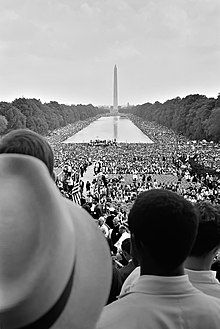National Mall


The National Mall, often just called the Mall, is an open park in the city center Washington, D.C. It has many museums, like the Smithsonian and the National Gallery of Art. It is found between the United States Capitol and the Washington Monument, which are about one mile apart. It is a popular place, and is used for exercise, recreation, music concerts, festivals, and protests. It is also visited by many tourists - over 25 million people come to the Mall each year.[1]
Area[change | change source]
Officially, the Mall is the area between the U.S. Capitol and the Washington Monument. However, there is another park that is right next to the Mall, which is from the Washington Monument to the Lincoln Memorial. The Reflecting Pool is in this park, as well as many monuments and museums. Many people say that this park is also part of the National Mall.
The National Mall has many trees. Most of them are elm and cherry trees. The cherry blossom trees were given to the United States by Japan in 1912.[2]
History[change | change source]
Pierre L'Enfant, the man who planned Washington D.C., wanted to have a park in the middle of the city. However, the National Mall was not always a park. In the 19th century, there was a railroad that ran through the Mall. Cows also grazed (ate grass) on the Mall.[3] There was a large market on one side of the Mall. During the American Civil War, there were many buildings on the Mall. There were even slaughterhouses on the Mall - places where animals are killed and turned into meat.[4] In 1901, the Senate passed the McMillan Plan. This cleaned up the National Mall and moved the railroad to Union Station.
Events[change | change source]

Many events happen at the National Mall. The National Park Service says that over 3,000 events happen each year, but most of these are tours.[1] Some of the biggest events that happen each year are the Cherry Blossom Festival, the National Book Festival, an Earth Day festival, and parades on Veteran's Day and Independence Day.
Protests and rallies also happen at the National Mall. One of the most famous was the March on Washington for Jobs and Freedom in 1963, where Martin Luther King, Jr. gave his I Have a Dream speech. A rally in 1969 to end the Vietnam War was the biggest protest on the Mall. Over 2 million people came and marched to the White House.[5] In 1995, the Million Man March was held on the Mall.
Museums and monuments in the Mall[change | change source]
- Washington Monument
- National Museum of American History
- National Museum of Natural History
- National Gallery of Art
- West Building of the National Gallery of Art
- East Building of the National Gallery of Art
- United States Capitol
- Ulysses S. Grant Memorial
- United States Botanic Garden
- National Museum of the American Indian
- National Air and Space Museum
- Hirshhorn Museum and Sculpture Garden
- Arts and Industries Building
- Smithsonian Institution Building
- Freer Gallery of Art
- Arthur M. Sackler Gallery
- National Museum of African Art
Near the Mall[change | change source]
There are many places very close to the Mall. The Library of Congress and the United States Supreme Court building are just east of the Capitol. The White House, the National Archives, the Old Post Office, and, Ford's Theater (where Abraham Lincoln was killed) are just north. The National Postal Museum, and Union Station are northeast. The Jefferson Memorial, the Franklin Delano Roosevelt Memorial, the United States Holocaust Memorial Museum, and the Bureau of Engraving and Printing are to the south.
References[change | change source]
- ↑ 1.0 1.1 Stone, Andrea (2007-11-14). "Private donations sought for National Mall". USA Today. Retrieved 2008-06-10.
- ↑ National Park Service (2007-01-25). "Cherry Blossom History". National Mall & Memorial Parks. Retrieved 2008-06-10.
- ↑ Fletcher, Kenneth (2008-05-01). "A Brief History of Pierre L'Enfant and Washington, D.C." Smithsonian.com. Retrieved 2008-06-10.
- ↑ Van Dyne, Larry (2008-03-01). "Turning Points: Moments in DC's History". Washingtonian. Retrieved 2008-06-10.
- ↑ "1969: Millions march in US Vietnam Moratorium". BBC. 1969-10-15. Retrieved 2008-06-10.
